For mixed finch combinations it would be best to speak to the breeder who will be supplying your birds. With plenty of space, most of the species mentioned in this guide can cohabit, but there will always be individual birds that break the mould by being more aggressive or more timid than a typical member of their tribe. And there are a few commonly kept species that are usually too aggressive to intermingle in anything but the biggest of aviaries.
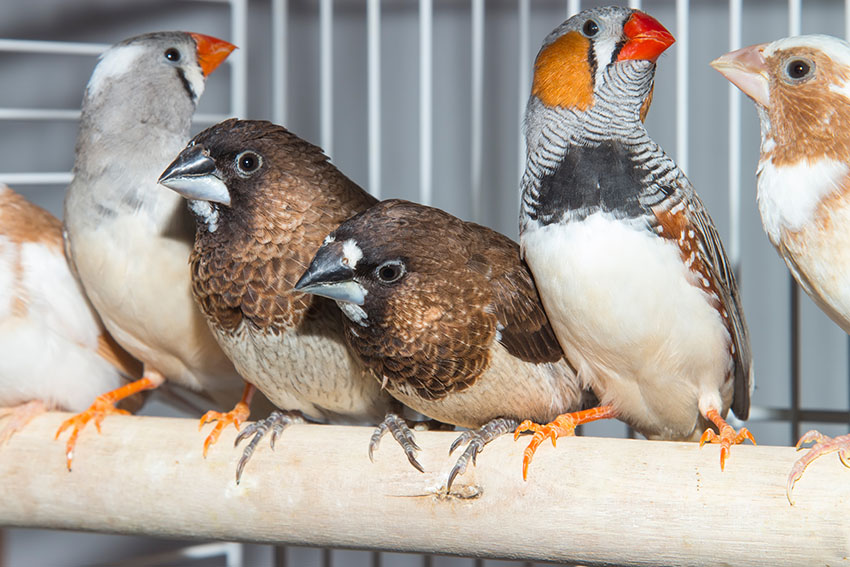
Zebra and Bengalese finches can intermingle, as long as they have lots of room
A good rule of thumb is to keep timid birds with other timid birds, pushy ones with other pushy ones, and to avoid bringing aggressive species into a generally ‘passive’ aviary. Use the following as a general guide, and always ask for advice from the person providing your birds (i.e. these bullets only list the species mentioned specifically in this guide):
- Generally speaking, the following can live together happily: Gouldian finch, Double-Barred (Owl) finch, Bengalese (Society) finch, Plum-headed finch, Red-headed parrotfinch, Chestnut and Scaly-breasted munia.
- The Star finch needs extra space and cover, due to its timidity. They are generally happier in flocks of their own kind.
- Canaries need big aviaries if they are to successfully cohabit. Living singly or in pairs is their preferred domestic setup.
- The following finches can cohabit if there’s plenty of space, but you’ll need to keep a close eye on the bullies: Zebra finch, Java sparrow, Strawberry finch, Lavender waxbill.
- These are the real bullies in the pack: Diamond firetail, Cut-throat finch.
Keeping a Single Finch
With the exception of Canaries, it is not possible to keep a pet finch healthy and happy if it is alone. All pet species will be happy in a pair, and for many this is the ideal permanent setup; but some only really thrive with the full interaction of a flock. If a shop or dealer is offering to sell single birds with no questions asked, you should question their competence - a good seller knows that a single finch is an unhappy and unfulfilled bird.
Keeping Finch Males or Females Together
Finches are best kept in cock-hen pairs. Single birds will be fine together in a larger flock (at least three pairs), and juveniles will perch and feed together happily, until that moment when the hormones kick in (after about nine weeks) and they have the urge to pair up. At this point, male-male or female-female pairs will begin to fight, if they are being kept together with no other birds.
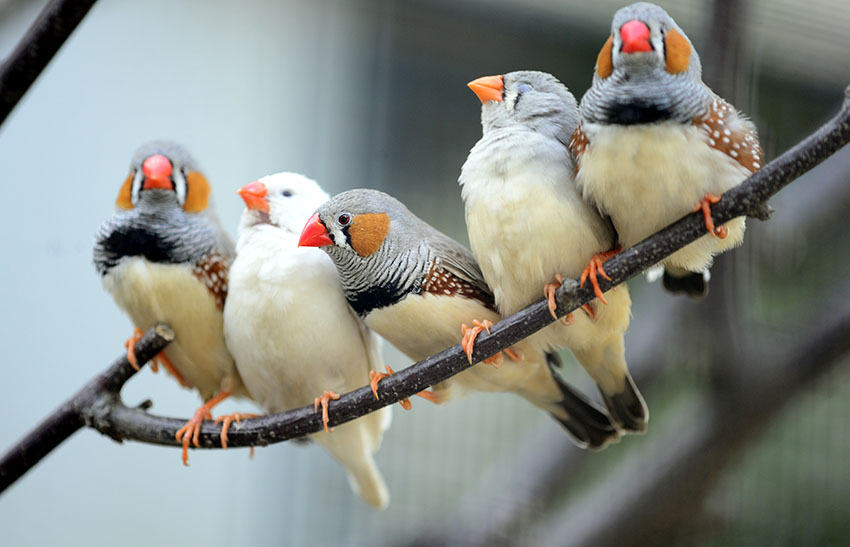
Pairs or flocks - the usual set up for most finch communities
Any unpaired birds will tend to live alone, rather than with their fellow singletons. In the case of cock birds, they can cause confrontation in a cage by vying for the attention of a hen who has already chosen her mate. Zebra finches, and many other species, are usually monogamous, so a single bird will have a long wait unless new blood is introduced into the aviary.
Keeping Canaries with Other Birds
Canaries are good natured birds. Two males or two females together will squabble; but any other combination usually works very well. Three or four males, for example, should be able to cohabit without going head to head. This easy-going nature also makes Canaries good mixers, and they are highly unlikely to intimidate any other species.
But there are two sides to the coin, and the problems with Canary cohabitation in an aviary come from the other species. Many finches are territorial and will bully a less aggressive bird such as a Canary. A mixed aviary will always have a detrimental effect on Canaries’ breeding prospects, as they need peace and quiet to successfully fledge their young.
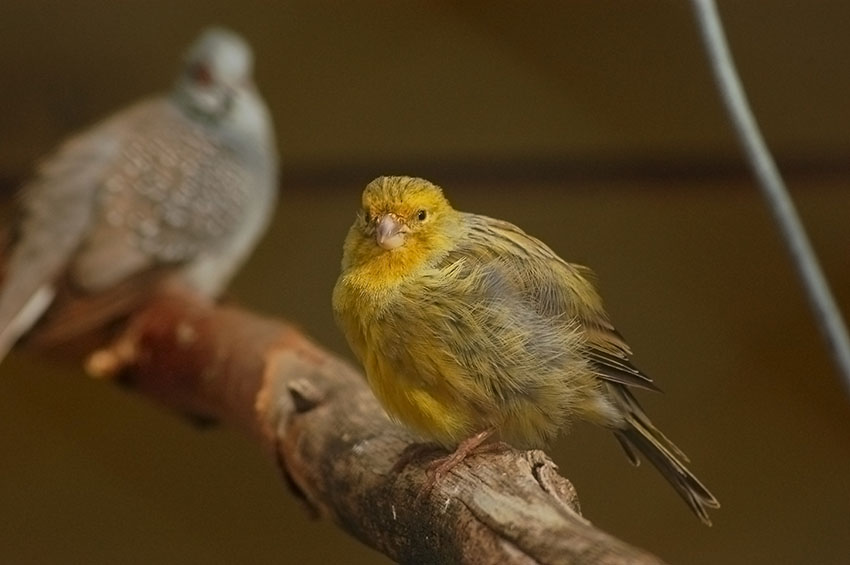
Although Canaries prefer their own company, they can still thrive in a mixed aviary
Establishing a harmonious community of birds depends on two factors - space and species. If your aviary or bird house is big, the potential bullies and their potential victims will be able to stay away from each other - the dominant bird’s aggressive body language will be enough to keep other birds away, without resorting to physical attacks. Keeping at least two separate feeding stations is necessary, otherwise a bully might establish himself on the food tray and not let anyone else get near. You also need lots of roosting perches high up in the aviary. The birds will compete for the high perches, so making sure there are plenty eases a lot of tension in the daily settling-down routine.
As a bird keeper, one of your jobs is to watch the aviary and assess the situation. The occasional peck and half-hearted chase is nothing to worry about. It’s only when these things become persistent and prolonged that you need to intervene (usually by netting and isolating the bully).
Canaries and Other Finches
Of the finch species mentioned in this guide, the most easygoing ones to house with Canaries are the Star finch and Bengalese finch. The Zebra finch may sometimes seem like the more obvious choice because of its wide availability and popularity, but it’s more aggressive than the Star or Bengalese (and indeed many other finches available in the pet trade), and you’ll need a very big aviary if the mix is to be successful.
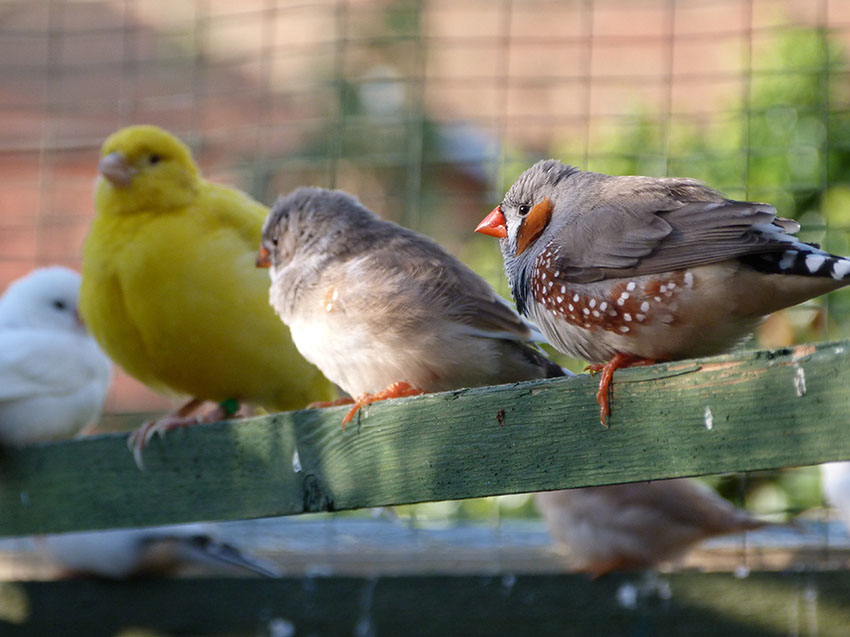
Canaries and Zebra finches can only live together if there's lots of space
Even with a mix of docile birds you need a cage at least 120cm wide. In a space of these limited dimensions you can house Canaries with Bengalese, Star, Gouldian, Double-barred and Plum-headed finches, Chestnut munias and Parrotfinches.
Canaries and Budgies
Lots of space is the key if you want to keep Canaries and Budgies together. A 10-metre wide aviary is a minimum requirement. Budgies don’t persecute Canaries as such, but they’ll defend their perch or feeding station with a hefty peck - budgies have relatively powerful, hooked beaks - which can cause a lot of damage to a creature as fragile as a Canary (or any other small finch). Budgies and other parrots tend to peck at other birds’ legs, and can snap a Canary leg like a twig. If cohabiting, the Canaries will need their own dedicated space in the aviary.
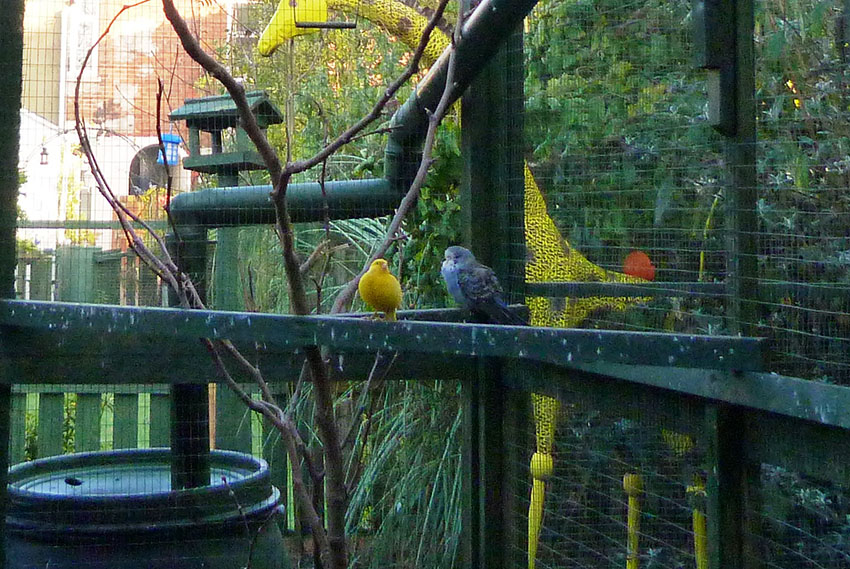
Canaries and budgies need lots of space, including separate feeding and roosting areas
The setup can work, and you will sometimes see aviaries with even more ‘dangerous’ finch cohabitees such as cockatiels, parakeets and lorikeets. But these arrangements only work in very big aviaries of the sort of scale you find in parks and zoos. For anything smaller than 10 metres in width, the simple rule is to avoid mixing finches and members of the parrot family.
Keeping Zebra Finches and Budgies Together
As Canaries, Zebra finches and Budgerigars are the three most popular cage birds in the world, it is not unreasonable to assume that they will all get on well together. Zebras actually do a lot better with Budgies than the more nervous Canaries, and in an aviary or birdhouse the two unrelated species will go about their business without taking much notice of each other.
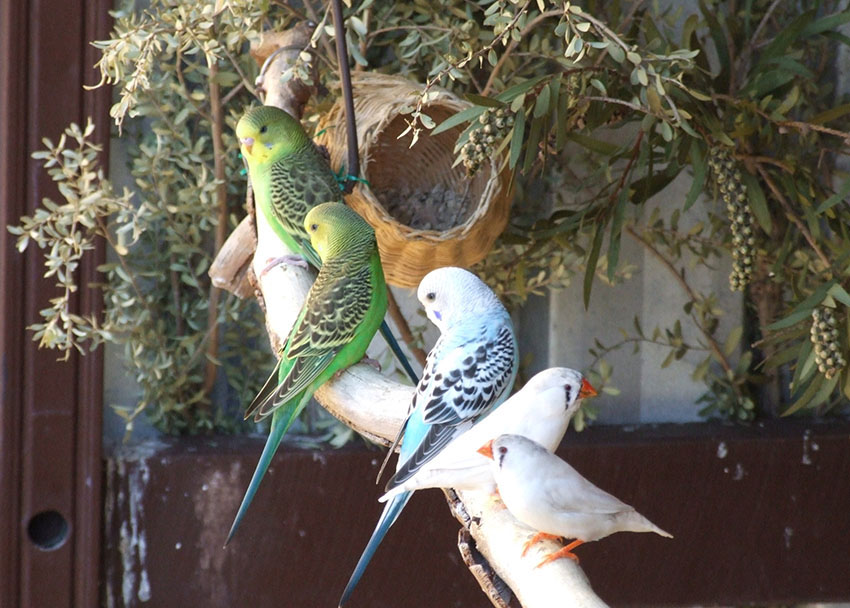
Zebra Finches, both natives of Australia, thrive together in a large, mixed aviary
Keeping Finches and Quail Together
If you’re keeping finches in spacious outdoor quarters, they can share their aviary or birdhouse space with quail. The commonest types available in Europe are the tiny Chinese painted quail, aka the Button quail or King quail (Coturnix chinensii), and the Japanese quail (Coturnix japonica). These will scuttle about on the aviary floor in a separate little world of their own, and will be unfazed by all the finch fuss and noise going on above them.
Keeping Finches and Doves Together
Doves are not a common mixed aviary bird (in spite of the popularity of free-flying fancy doves and pigeons). Some keepers mix them in with their finches and parakeets, though, and they are placid - and large - enough to get along in most setups.
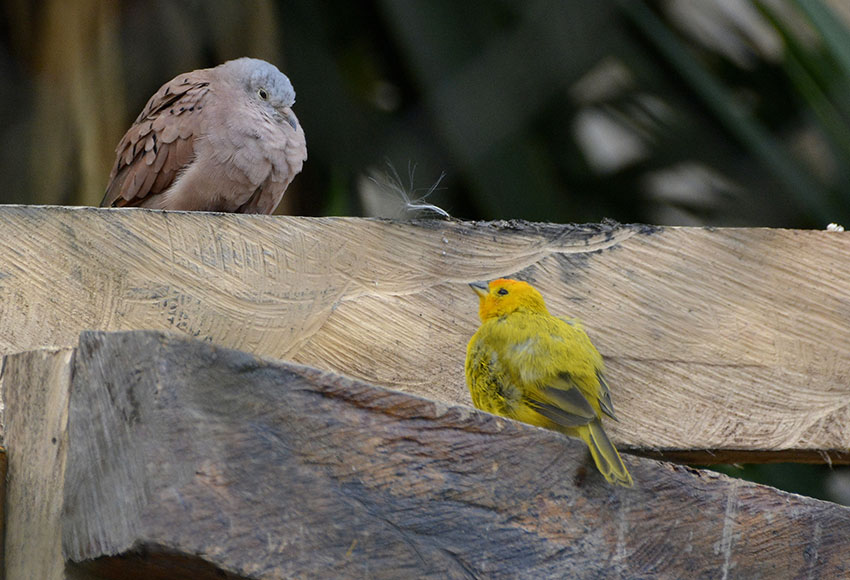
Finches and doves mix well in an aviary, each respectfully ignoring the other
Common pet trade species include the Ring-necked dove (Streptopelia capicola) and the Diamond dove (Geopelia cuneata). The latter is popular due to its diminutive size (for a pigeon) of 20cm, whereas the Ring-necked is a sleek but substantial 30cm. Both birds (like all members of the pigeon family) need lots of grain in their diets, so a standard finch or parakeet mix will not provide them with what they need.



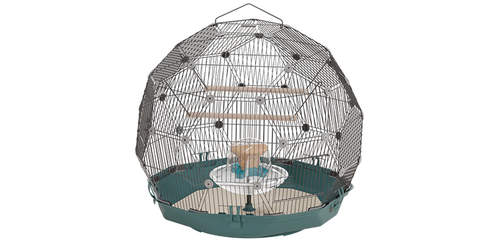
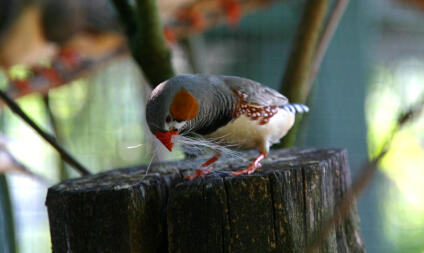
Comments
Gail, 6 April 2024
I have budgies and a canary. My canary desperately wants to cohabitate with the budgies; but, unfortunately i've found my canary with an injuried bleeding leg causing him pain on several occasions and have even seen one of the budgies chase him. This does not seem to deter the canary as whenever he can access the budgies he tries despite having been injurred by them. I let them fly free; but, now keep them in seperate rooms.
Phillip, 16 October 2022
I have a fife canary who got along very well with my old fifes that died. She is in a good sized cage for her size, and I was wondering if I could keep a budgie with her or not? Every article I've seen pretty much says to do it at your own risk, but I would like a definitive answer from someone more experienced than wikihow. The cage is 3 feet across, 2 1/2 back, and 3 feet tall. I would be able to take the budgie out every day and would have seperate waters and foods for them both. TL;DR can I keep a budgie with a passive but friendly canary?
Nathan, 2 March 2022
I am just wondering what birds can live together as I have button quail. Zebra finches, lovebirds, budgies, cockatiels. What out of them can be in a large avairy please
Cherry, 7 February 2022
Sorry - just to clarify: the Bengalese is the English (UK) name for the finch that is referred to as the Society in some other parts of the English speaking world! The biological name of the bird I am referring to is Lonchura striata domestica, though it is not always regarded as a full subspecies and is sometimes listed simply as Lonchura striata.
Cherry, 7 February 2022
For Wendy, in case it is still useful, and with apologies if I'm repeating things you already know: The short answer is that the Bengalese finch is indeed extremely social and company is better if at all possible. In the type of situation you describe, it would probably be worth trying to pair the bird with another, possibly an older, weaker bird, of either sex. If that doesn't work, then keeping her within sight and sound of others while out of beak reach, may be the best solution - plus talking to her as much as you are able. It might also be worth trying to pair her with a bird of a different species of similar temperament, but that's obviously more complicated in practical terms. The long answer is that a lot of flocking animals are gregarious rather than social, and will pick on a sick or otherwise "abnormal" individual: it's supposed to be because it's liable to make the flock a target for predators. This may be less likely to apply if you have only two together out of sight and sound of others, but it is hard to know. This is why finding another bird which is not in the absolute prime of health may have a better chance of working. I have never actually tried keeping two females in one cage, but I would do it without hesitation, and without expecting the birds to have any issues - the only thing to be aware of is that it is likely to be noiser than a male and a female or two males. Females have a tendency to squawk for male attention (as far as I can make out), and it is both louder and a less "aesthetic" sound than the males singing. As far as setup goes, the standard advice is that visual barriers and more than one food and water source generally help reduce aggression; I have the impression that the more enrichment they have - whether it is interesting food or swinging perches or live plants - the better they tolerate each other, but I haven't done any sort of controlled experiment on the subject. (They seem to like an approximately equal mixture of open space and plant clutter, though again, that is only an impression). I have found, with mine, that they will try to breed relentlessly if you keep males and females together, and even if you want to breed them, it's necessary to impose some restrictions. If you're happy taking eggs away, that does work, and I've found I can usually stop them laying by repeatedly disturbing the nest they are trying to build - though they do just start again. They have a dreadful habit of nesting in food bowls: tube feeders or wild bird feeders are normally ok, but I don't know if that would work for your particular bird. I currently have a pair nesting (with permission) in a grass dome in one of the flowerpots! Anyway, hope that is of some help and hope your bird continues to enjoy life :-)